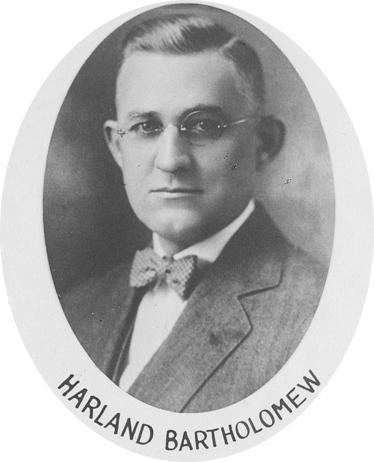Name Harland Bartholomew Role Urban planner | ||
 | ||
Books Land uses in American cities | ||
Harland bartholomew event promo
Harland Bartholomew (September 14, 1889 – December 2, 1989) was an American urban planner. Although a civil engineer by training and disposition, Harland's career started just as the automobile production was about to take off, industrial development was booming and urban populations grew. The novel challenges and opportunities brought about by this new form of transport inspired the invention of new community concepts and required the development of new approaches to planning transportation in cities. These challenges called for the skills of an engineer to analyze transportation needs quantitiatively as well as those of a person passionate about urban design and social conditions. Harland was able to deliver these qualities. Starting in 1911 and continuing until 1930 Harland Bartholomew created new methodologies and new designs and concepts which made contributions that remain relevant to urban planning in North America today. This novel approach became known as comprehensive planning. His skills and experience were sought by many city planning commissions. Ultimately cities would develop their own in house technical staff to carry on with planning issues. Harland himself was the first full-time planner employed by an American city, and he remained a planner with St. Louis, Missouri for 37 years. During this period both the city of St. Louis and its surrounding areas were thriving and growing. Due to his groundbreaking work he can be described as the father of American and Canadian city planning in the age of the automobile.
Contents
Early life
Bartholomew was born in Stoneham, Massachusetts on September 14, 1889 but moved to New York City when he was 15 and attended Erasmus High School in Brooklyn. He completed two years of a Civil Engineering degree at Rutgers, but due to lack of funds, was unable to continue his studies. He received an honorary degree in Civil Engineering from Rutgers University in 1921. In 1912 he landed a position with E.P. Goodrich, a civil engineering firm that happened to be a strong advocate for the efficient planning of cities. His work with Goodrich consisted principally of conducting traffic counts on bridges, a task that Bartholomew found dreary but that prepared him for a life of planning around infrastructure and automobility.
Planning activities conducted
Career
In 1914, the Newark, New Jersey plan commission retained Bartholomew as the first full-time, public-sector city planner in America. In 1915, prominent civic reform advocate Luther Ely Smith, on the advice of the architect Henry Wright, recruited Bartholomew to St. Louis to serve as the city's first planner. He served in that capacity until 1950. In 1919, he established Harland Bartholomew and Associates and served as its chairman until his retirement in 1962.
From 1918 to 1956 Bartholomew taught civic design at the University of Illinois and made substantial contributions to the scholarly and practice literature in city planning. In 1932 he completed his landmark study Urban Land Uses, published by Harvard University Press in the City Planning series edited by Theodora and Charles Hubbard. Bartholomew also published dozens of studies and articles in venues including the City Planning Conference Proceedings, American City, The "Annals of the American Academy of Social and Political Science", American Civic Annual, City Planning, the "Journal of Land and Public Utility Economics", and the National Conference on City Planning Bulletin. His writing covered a wide range of practices. He wrote on topics such as the theory and practice of zoning, street widening, cost distribution, placement of railroads, easements, federal buildings in cities, growth controls, economic disintegration, subdivision layout, slum clearance, metropolitan and regional planning, and the role of neighborhoods in the plan process.
Bartholomew's career received notice by the administration of President Dwight D. Eisenhower, particularly for his work on the Washington Metro, as chairman of the National Capital Planning Commission, and as a leading advocate of society first planning for freeway building. He was appointed to Federal planning committees by three US Presidents—Herbert Hoover, Franklin D. Roosevelt, and Dwight D. Eisenhower. However, many of Bartholomew's views are discredited today. For example, he pioneered urban renewal decades ahead of its time through the use of eminent domain in 1938 to clear the St. Louis Waterfront for the Jefferson National Expansion Memorial. He advanced the concept of identifying obsolete neighborhoods through cost accounting (amount of taxes garnered versus city services expended), and was a major advocate for functional, single-use zoning and for automobile-oriented planning.
Controversy
There have been a number of claims made about Harland Bartholomew's planning. In St. Louis, his planning was used to great effect to maintain racial segregation in cooperation with local realtor associations. In several other cities, Bartholomew's planning was found to be in line with racial, social, and economic segregation.
